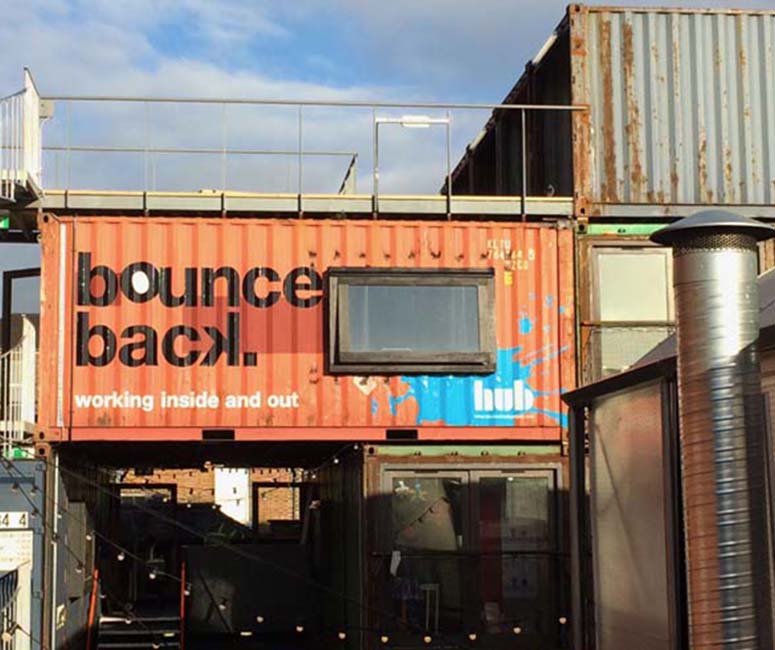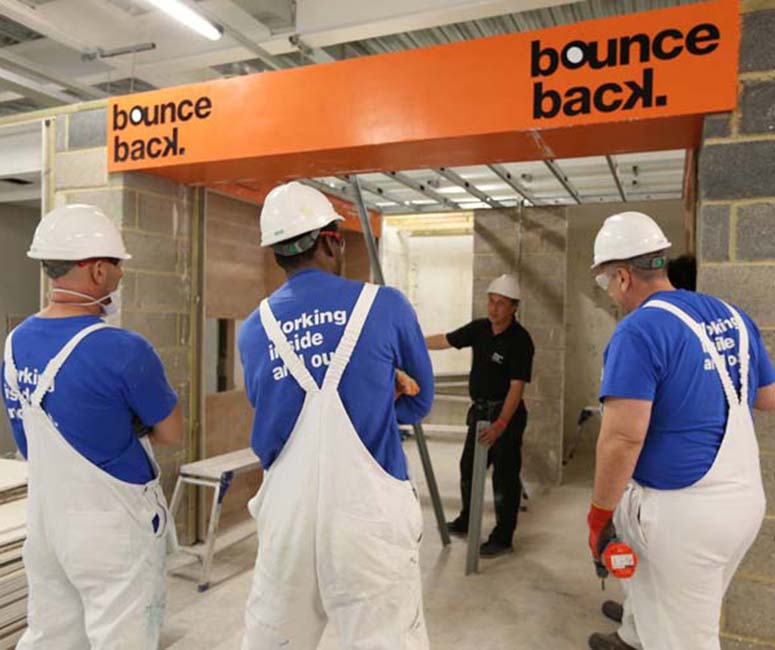Aiming to tackle the construction skills shortage, along with prisoner rehabilitation, Landsec has partnered with Bounce Back to launch a scaffolding training course inside Brixton Prison.
Towering brick walls and barbed wire line the exercise yard at Brixton Prison. A heavy steel door creaks open to let two or three men in hard hats pass through before slamming shut, the sound reverberating across the vacant ground they left behind.
On the other side, a different kind of prison greets them: a prison whose goal is not to trap them in its walls and barbed wire but to open them up to opportunities for a future that is free and independent.
Last October, Landsec launched the UK’s first scaffolding course inside a prison, partnering with Bounce Back, a charity that trains prisoners to get them back into paid work. With profits being squeezed in the construction industry, and Brexit posing the potential to exacerbate the already dramatic skills shortage, the initiative feeds directly into one of the economy’s most pressing issues.
For 20 weeks, inmates, all of whom are inside for non-violent crimes or nearing the end of their sentence, train through the morning and afternoon, getting to grips with scaffolding and readjusting to daily work after years of unemployment.
The goal is rehabilitation: to give men who might not have any prospects for a successful, productive return into society what they need to achieve that. Those who build a 10m tall structure become Level 2 Diploma-certified scaffolders and are guaranteed a job interview with construction company Alandale Plant & Scaffolding, the company that donates all the equipment for the course.
https://twitter.com/RoryGeo/status/867699491629142016
The project is a natural progression for Landsec’s community program, which has committed to securing 1,200 jobs for “disadvantaged people” by 2020. Since 2011, the team has worked on projects targeting the long-term unemployed, the homeless and young people.
The course was conceived and initiated by the company and in Brixton it is something of a mediator, bringing together the right stakeholders – Bounce Back and Alandale – to get projects off the ground. It first worked with Bounce Back in 2015 to set up a dry-lining course at the prison.
Debbie Akehurst, head of economy and communities at Landsec, says organisations like Jobcentre Plus started referring ex-offenders to the company years before the Brixton Prison courses started, which set off a light bulb moment: “That’s really where it started to expand from. We started to really think about how we could help people and tap into that talent that’s in the prison system.”
Creating a “hub of activity” in Brixton that cultivates that talent made sense to Landsec on a business level considering the skills shortages in the industry: “For us to have a skilled construction workforce for the future, it makes absolute sense in terms of business and carrying on with business,” Akehurst says.
“We knew there was a particular issue with construction skill gaps, and we wanted to make sure that what we were doing was helping to address some of those issues.”
Changing perceptions
But business interests are a small part of the goal. Landsec and its partners are tackling barriers most ex-offenders face when they are released, barriers that make it nearly impossible for them to settle back into society.
Matt Warner, managing director of Alandale, says: “First they come out with no money. How do they get the money to pay for themselves to go and do their CSCS [Construction Skills Certification Scheme] card, plus pay their rent, plus their travel? To complete all of that is £500-£600. They have no choice but to go and steal.
“The government is not allowing them to come out and get back into work.”
It comes as no surprise to the partners that the national re-offending rate is more than 50%. Ex-offenders are thrust into a world where nearly two-thirds of employers will not consider anyone with a criminal record regardless of their skills.
Fran Findlater, founder and chief executive of Bounce Back, launched the charity in 2010 to fight the stigmas attached to prisoners. Changing perceptions, she argues, will break the cycle of re-offending, making streets safer and returning people to their families and communities.
It also saves the state around £78,000 a year to train an inmate and get them back to work rather than to keep them locked up.
She says its programs give inmates a grounding beyond the hard skills: “No one is pretending these guys are going to come out absolute master builders.
“They’re going to come out with an understanding of going to work, getting up in the morning, finishing at the end of the day – understanding what that’s about.”
She recently met an inmate at Wandsworth Prison, where Bounce Back started working last year, who went into the dry-lining course with no experience and no skills.
He quickly became so engrossed in the work that, he says, they could not get rid of him at the training centre. “He’s now better at health and safety than anybody else in my organisation,” Findlater says.
Other prisons are starting to take notice too. Landsec, Bounce Back and Alandale run regular open days at Brixton, inviting representatives from other institutions to look at how the scaffolding course is run and how they could expand the course into their own prisons.
Whether places like Thameside or Willesdon will sign on is still up in the air, but all three organisations are confident that changing perceptions and rehabilitation through construction will not start and end in Brixton.
The impact
With only enough space for 12 students at a time, the waiting list for scaffolding has risen to 75.
About 40 inmates, including the current cohort, have taken the course so far. Of these, 24 have finished and about 10 are in work, which is in line with Bounce Back’s target of getting 40% of trainees into paid employment. Between dry lining and scaffolding, the charity has trained just under 200 inmates.
More telling, however, is that the reoffending rate among inmates who have taken one of the courses is 12% – about a quarter of the national average.
Charlie
One of the prisoners like that in Brixton is Charlie, an inmate who is spending the last three months of his sentence finishing the scaffolding course. Charlie brims with excitement when he talks about securing a job with Alandale, pausing to take a look at the half-finished scaffolding in front of him, which has been built and taken down 25 times: “It looks like a game of Kerplunk I suppose – tubes going round everywhere!”
Having worked in scaffolding for 14 years before his arrest for what he calls a “spur of the moment fight”, he now helps others on the course who are just starting, pitching in whenever the on-site instructors need another pair of hands.
“I’ve spoken to people on the wing and they want to get on Bounce Back because there’s not a lot of progressive jobs in here. So coming over here is something they can look forward to every day: to come out of their cell, to come over here and do practical work.”
Despite his giddiness to be out again with secure working prospects, Charlie seems just as keen to come back – this time to teach. He is working with the charity to see whether it is possible for him to come back in to lead courses himself.
Whether or not that works out, Charlie is trying to secure a place in next year’s London Marathon to fundraise for Bounce Back, spending his whole 45-minute exercise time every day jogging round the exercise yard.
A work in progress
Even as numbers grow in both the scaffolding and dry-lining courses, a new problem has cropped up for Bounce Back and Alandale. Trainees are required to build 10 metres of scaffolding for their final assessment, but Brixton prison only allows for a 7m high structure for security reasons. This means inmates have to complete their course in Alandale’s own space, which has become increasingly difficult because Brixton no longer offers daytime release for prisoners.
Release on temporary leave, or ROTL, was an integral part of the scheme when it was conceived but this was scrapped in January due to in part to the amount of contraband that was being brought back into prison.
Prisoners would start the course on the inside, spend some time working in an Alandale training centre and complete their assessment there. It would get them certified by the time of their release, allowing them to go straight to work.
Without ROTL, inmates will do part of their course inside and will be released before they do their final assessment. Warner worries this is more than an inconvenience. It would disrupt prisoners’ progress in building up a daily work routine.
Warner says: “It’s all about conditioning. If you condition them now to get up every day, to go into work, to go home, to go to bed, to get up again and do it the next five or six days a week, when they come out, they’ll naturally continue doing it.
“But when they finish the course and they’re banged up for another 6 months, by the time they come out, that momentum and inspiration is gone.”
At other times, there have not been enough guards to oversee the training, which means that men on the course might do a few days of scaffolding and then spend the next few locked in their cells, also disrupting the routine the course tries to instil in them.
This means the course is still a work in progress. Bounce Back and Alandale are trialling schedules to get the most out of the 20 weeks, while also ensuring that the prisoners’ release coincides with the end of the course as much as possible. But the hope is that ROTL will eventually be reinstated and prisoners will be allowed to train outside Brixton’s walls.
To send feedback, e-mail karl.tomusk@egi.co.uk or tweet @ktomusk or @estatesgazette














